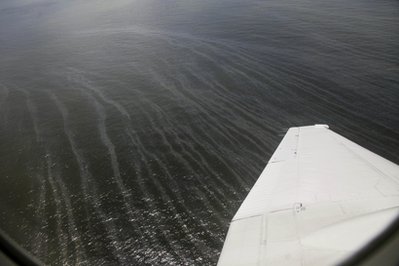-
News >World
Storms threaten to shut down BP's Gulf well work
2010-07-22 03:44NEW ORLEANS - Tropical rainstorms moving toward the Gulf of Mexico on Wednesday threatened to shut down undersea efforts to seal BP's ruptured well, interrupting work just as engineers get close to plugging the leak with mud and cement.
Retired US Coast Guard Adm. Thad Allen said a weather system brewing in the Carribean could force crews to abandon their watch over the experimental cap that's been bottling oil a mile (1.6 kilometers) below the surface of the water for nearly a week.

Oil streaks are seen below the wing of Louisiana Gov. Bobby Jindal's plane near the Deepwater Horizon oil spill site over the Gulf of Mexico, off the Louisiana coast, Tuesday, July 20, 2010. [Agencies]Scientists have been scrutinizing underwater cameras and data for days, trying to determine if the cap is displacing pressure and causing leaks underground. If storms keep them from seeing the cap and getting those readings -- for up to four days, Allen said -- BP could reopen the well to avoid missing signs it is buckling.
"This is necessarily going to be a judgment call," said Allen, the federal government's point man on the spill who will make the ultimate decision.
Forecasters say the storm system likely will move into the Gulf of Mexico over the weekend, although it appears to be weakening. Right now, it has a 60 percent chance of becoming a tropical depression or storm within the next 48 hours.
Even if the storm doesn't hit the area directly, it could affect containment and cleanup. Hurricane Alex didn't get closer than 500 miles (804 kilometers) from the spill in late June, yet offshore skimming in Alabama, Mississippi and Florida was essentially curtailed for nearly a week.
In Florida, crews were removing protective boom intended to buffer the state's inland waterways in the Panhandle from oil. High winds and storm surge could carry the boom into sensitive wetlands, damaging those areas.
Allen said BP and government scientists were meeting to discuss whether the cap could be monitored from the shore.
It could take several days to evacuate ships from the well site 50 miles (80 kilometers) off the Louisiana coast, where the BP-leased Deepwater Horizon rig exploded April 20, killing 11 and touching off one of America's worst environmental crises.
Allen said an evacuation could delay operations as much as two weeks before work would resume to kill the well at the bottom.
Shell Oil, the US arm of Royal Dutch Shell PLC, already has begun evacuating personnel not essential to producing and drilling on their operations in the Gulf.
BP crews are in the final stages of readying a relief tunnel before boring into the side of the ruptured well to dump heavy mud and cement, sealing it for good. BP also may pump mud and cement from the top, to make efforts at the bottom easier. That procedure, called a surface kill, would occur before the well is ultimately plugged from below.
Before talk of nasty weather, BP was inching closer to completion and had hoped for a permanent plug by early August.
The well has spewed somewhere between 94 million gallons (355 million liters) and 184 million gallons (696 million liters) into the Gulf. BP has invested $4 billion on the spill so far.
The temporary cork in the well has helped cleanup efforts, and Allen said skimming vessels are starting to have trouble finding oil to collect. BP has about 1,600 boats operating daily in waters off Alabama, Florida and Mississippi, 600 fewer than last week, said Matt Kissinger, director of BP's "vessels of opportunity" program in the region.
